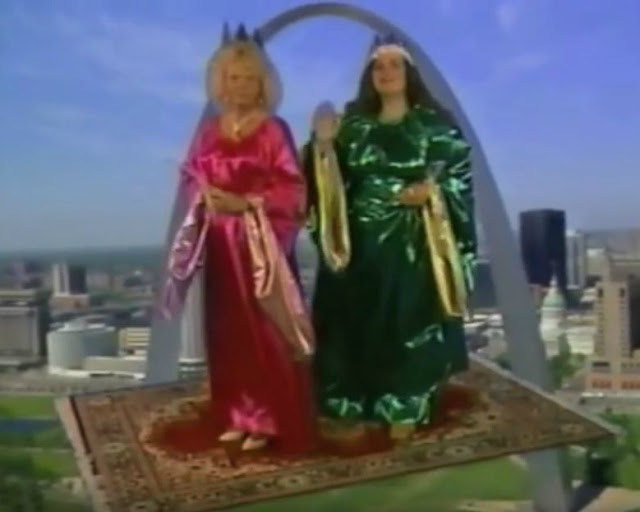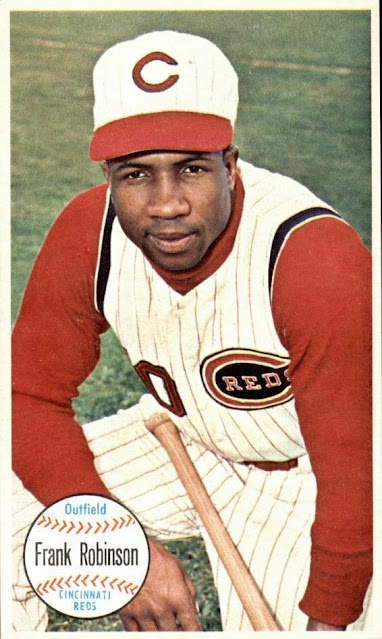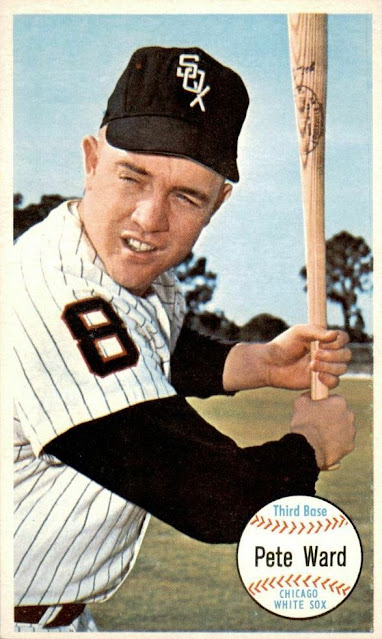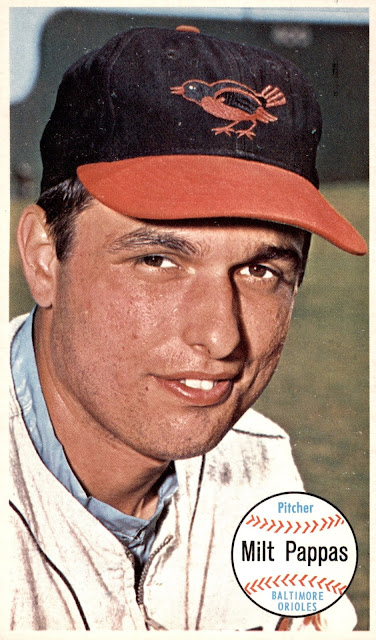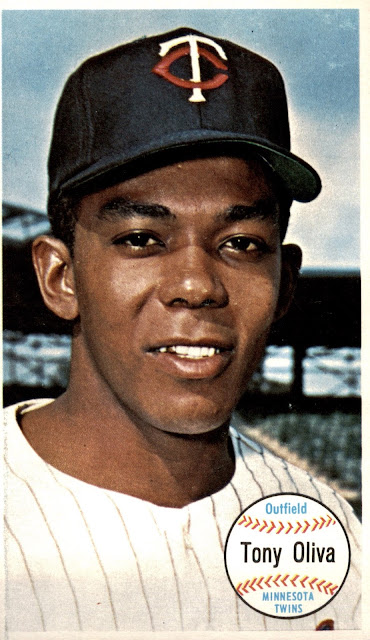Monday, March 28, 2022
Random Ray - 1990 Topps TV
Monday, March 21, 2022
Random Ray - 1995 Topps Finest
The baseball card purist in me cringes when I see the Topps Finest cards from the second half of the 1990s. At the time, Finest was a popular, high-end brand and had done some innovative things with cards that are still around today. Namely, the brand created the refractor cards. The 1995 Finest was the start of a short-lived, terrible "innovation".
So, what was cringeworthy about the 1995 Topps?
Let's look at this week's Ray Lankford card.
I love this photograph of Ray Lankford batting and wearing sunglasses. The blue, road Cardinals hat is an added bonus. What the heck is stamped across his face? It's actually a protective coating that was supposed to protect the surface of card from surface flaws. It is hideous. Definitely cringeworthy.
Why was this a thing?
I have long been tempted to go through my boxes of late 1990s Finest cards and rip all of the "Finest Protector" sheets off, but at the same time this is how the card came out of the pack. This has all the trappings of a good mid-1990s baseball card, but the fact that I even have to think about whether to peel a plastic protector off the card is a huge negative in my book.
Back of the card.
There is no protective cover on the back of the card, but it is mentioned in the small print at the bottom of the card. That's unfortunate. Topps should have gone ahead and just slapped one back here too.Wednesday, March 16, 2022
Random Ray - 1997 Fleer Ultra Double Trouble
The first half of Ray Lankford's career was spent with a Cardinals team that was low on talent and payroll. There were always some decent players around, but the team's overlord at Anheuser-Busch would never commit to adding players who actually made the team competitive. It was not quite as bad as the modern Pirates, likely because August Busch III was limited to a five year run before he sold the team in the winter of 1995.
The current Cardinals owner bought the team at that point. The Cardinals hired Tony LaRussa, signed Andy Benes and Ron Gant as free agents, and traded for half the Oakland A's roster minus Mark McGwire. They put the McGwire trade off for a year and a half, but ended up with Todd Stottlemyre, Mike Gallego, Dennis Eckersley, and Rick Honeycutt. I am sure I am leaving someone out.
It was great to have good players on the team. It also meant that there were finally Cardinals cards included in insert sets that required the team to have more than one player.
For example.......
Now, Ron Gant's time in St. Louis ended on a sour note, but things were good when he first got to town. He hit a bunch home runs and the Cardinals made it to the National League Championship Series in 1996. Gant and Lankford were easily the Cardinals best players that season, hence the 1997 Fleer Ultra Double Trouble card.
These were really easy to find inserts with a decent design. The letters across the top with the alternating colors are a little much, but it's a 1990s insert. You need some pizzaz and flair. Well, not too much. The odds are listed at 1 per 4 packs, or 6 per box. Most can be found for a dollar or two at most. There are flashier inserts to be had, but they don't feature Ray Lankford.
Back of the card.
I am going to ignore the Ron Gant side of the card.
On the Ray Lankford side, they should have put the last sentence first and dropped the word also.
Sunday, March 13, 2022
A Giant Project Update #11
This is the giantest of Topps Giant updates. It has taken me awhile to assemble this set. Long than I thought, but I think that it actually helped to collect the tough short-prints and expensive Hall of Famers first. Since my last update in February, I have been able to find another 8 cards to cross off the checklist. Yes, there are short-prints in this post and Hall of Famers, but most were nowhere near the cost of the Mantle and Mays cards.
After my last post, I was closing in on the 2/3 mark for the set with 37 of the 60 cards. In the last month, I have brought that total up to 45.
A quick look at the new cards.
First up is Kansas City A's infielder Wayne Causey.
Wayne Causey's career year involved him finishing twelfth in the American League batting average leaders. I am not really sure that is the type of statistic and brag you want on the back of your baseball card. I guess it's better than saying he finished 21st in MVP voting that season. I think Topps could have squeezed it in:
"Wayne just missed out on the American League MVP in 1963, finishing just a mere 243 points behind Yankees catcher, Elston Howard"
This Frank Robinson guy seemed really good. I am not going to go look it up, but the Reds would be foolish if they ever traded him.
Ward still stuck around the Majors for a decade after injury, mostly with the White Sox. He played his last season as a left-handed bat off the bench for the Yankees. The back undersells his father a bit, which is the reason why I knew of Pete Ward before buying the card.
Way back in the day, there was an antique store in my wife's hometown in northern Michigan that had a spattering of sports cards and memorabilia. It was next to the town's incredible coffee shop. One of the items in the store was an autographed photo and old O-Pee-Chee card of a Montreal Maroons hockey player, Jimmy Ward. I am not good with old hockey players, but the price for the two items was outrageous.
I went home and Google searched the guy.
Not mine, nor the items at the store, but he was a member of the popular 1934-1935 Montreal Maroons Stanley Cup winner.
The card below is from Google. I don't buy hockey cards for hundreds of dollars. Nothing says popular Canadian sports star like appearing in an advertisement for syrup. Pretty dapper guy for a professional hockey player from the old days when they did not wear helmets. Although, maybe there is a reason his mouth is shut.
Back to baseball cards.
The back describes his skill on the mound. His playing numbers are solid.
Camilo was also a notable scout for the Mets, A's, and Dodgers following his retirement. Camilo convinced Cuban refugee Jose Canseco to sign with the A's, while also suggesting the team draft USC infielder/pitcher Mark McGwire. He also found a 15 year-old Tampa high school pitcher, Dwight Gooden, for the Mets. The majority of Latin American Dodgers players from the 1990s and early 2000s were discovered and signed by Camilo Pascal.
Next.
Heard this guy ended up on the Reds at some point.
I hope the Orioles got a good return.
The card is off-center. Although, in the grand scheme of things, this is a really inexpensive Roberto Clemente card. I might revisit this one at some point in the future. For the moment, I will take it.
I feel the need to make a post ranting about Topps use of "Bob" in Roberto Clemente cards.
Another really inexpensive Hall of Famer.
Finally a Topps Giants card talking about an established Major League players Minor League career. This set has tons of cards were parts of the back are taken up by their Minor League numbers. This is the first card in this post. The PCL was serious baseball. The Sally League? Yikes. Someone was reaching.
Final card.
Yes, Tommy Davis has two batting titles and helped get the Dodgers to the World Series, but here is something about his time with the Spokane Indians.
Eight more cards crossed off and I am at 75% of the set. Two Hall of Famers left and no short-prints.
1 Gary Peters
2 Ken Johnson
3 Sandy Koufax SP
4 Bob Bailey
5 Milt Pappas
6 Ron Hunt
7 Whitey Ford
8 Roy McMillan
9 Rocky Colavito
10 Jim Bunning
11 Roberto Clemente
12 Al Kaline
13 Nellie Fox
14 Tony Gonzalez
15 Jim Gentile
16 Dean Chance
17 Dick Ellsworth
18 Jim Fregosi
19 Dick Groat
20 Chuck Hinton
21 Elston Howard
22 Dick Farrell
23 Albie Pearson
24 Frank Howard
25 Mickey Mantle
26 Joe Torre
27 Ed Brinkman
28 Bob Friend SP
29 Frank Robinson
30 Bill Freehan
31 Warren Spahn
32 Camilo Pascual
33 Pete Ward
34 Jim Maloney
35 Dave Wickersham
36 Johnny Callison
37 Juan Marichal
38 Harmon Killebrew
39 Luis Aparicio
40 Dick Radatz
41 Bob Gibson
42 Dick Stuart SP
43 Tommy Davis
44 Tony Oliva
45 Wayne Causey SP
46 Max Alvis
47 Galen Cisco SP
48 Carl Yastrzemski
49 Hank Aaron
50 Brooks Robinson
51 Willie Mays SP
52 Billy Williams
53 Juan Pizarro
54 Leon Wagner
55 Orlando Cepeda
56 Vada Pinson
57 Ken Boyer
58 Ron Santo
59 Johnny Romano
60 Bill Skowron SP
Wednesday, March 2, 2022
Random Ray - 1997 Fleer Ultra
I am actually posting a copy of the Gold Medallion parallel. Nothing special, still a really easy card to come across. Plus, it's Ray Lankford. Go to a card show and you can probably find this card for a quarter. Maybe fifty cents if the card show is in St. Louis.
Here is the front of the card.
I love the 1997 Cardinals cards with pictures taken inside of Busch Stadium.
Busch Stadium had astroturf for all of my childhood. I say it like it's bad. The astroturf was great for the 1980s Cardinals teams, who were speed oriented. I never liked seeing the stuff on Cardinals baseball cards, but still liked the overall appearance of Busch Stadium.
Even though it was a cookie-cutter, concrete bowl, it was instantly recognizable. The Busch Beer blue walls, red seats, and arches around the top of the stadium made it a little bit better than places like Three Rivers, Riverfront, and The Vet.
In an attempt to class the place up a bit, the Cardinals ripped up astroturf at the end of the 1995 season and replaced it with grass. The team was also sold to its current owner, so the Busch Beer blue walls were all painted green.
Throw in a ridiculously large scoreboard in place of the majority of upper deck outfield seats and the place looked completely different for the 1996 season. I was always a little disappointed that the Anheuser-Busch eagle on the left-field scoreboard was replaced by an advertisement from the same company.
It's next to Highway 40 (Interstate 64 if you're not from St. Louis) now.
The green around the stadium was crisp.
That green grass and green paint really popped on baseball cards, especially with the white and red Cardinals home uniforms. There were a few 1996 Cardinals cards with the new grass and paint scheme in the background, but 1997 had a lot of Cardinals baseball cards with photos inside of Busch Stadium.
The 1997 Fleer Ultra Ray Lankford is one of the better updated Busch Stadium pictures from that year. You cannot even see the green paint on the card, just the grass and what is probably a Budweiser sign on the outfield wall. Still a great photograph when you put it all together.
Back of the card.
Yes, there are stats, but what about the color and sepia photos in the background. Those are quality. Almost makes me want to say forget the stats, just bring me more photographs of Ray.
106.
Blake Snell number 106 is just a red herring to make two other announcements. Announcement #1- I have not written very often in this sp...

-
Blake Snell number 106 is just a red herring to make two other announcements. Announcement #1- I have not written very often in this sp...
-
I had no idea who Earl Torgeson was before I bought this card a few days ago, but was intrigued when I Google Searched him and the bio from ...
-
I have made it to my first break in the school year and am excited about spending a little time the next few weeks at home with my cards. I...


